Chiến lược chữa lỗi bài viết trong giảng dạy kỹ năng viết cho người học ngoại ngữ
Trong những năm gần đây đã có rất nhiều những tranh luận xung quanh hiệu quả của việc chữa lỗi bài viết cho người học ngoại ngữ trong giờ giảng dạy kỹ năng Viết. Những nghiên cứu đầu tiên về chữa lỗi viết được thực hiện bởi Truscott (1996). Ông cho rằng, không nên chữa lỗi ngữ pháp trong bài viết của người học, bởi việc này không hiệu quả đối với việc nâng cao kỹ năng Viết cho người học. Phản đối quan điểm của Truscott, Ferris (2008) cho rằng, việc xử lý lỗi viết, bao gồm việc chữa lỗi của giáo viên, là rất quan trọng trong việc giảng dạy kỹ năng viết. Xung quanh vấn đề này còn có rất nhiều nghiên cứu về cách tiếp cận lỗi của người học ra sao cho phù hợp cũng như các chiến lược chữa lỗi hiệu quả cần được áp dụng như thế nào trong giờ dạy kỹ năng Viết cho người học ngoại ngữ. Do có nhiều tranh luận về các biện pháp chữa lỗi khác nhau nên bài viết sẽ nghiên cứu các chiến lược chữa lỗi với mục đích phân tích những điểm mạnh và điểm yếu khác nhau của mỗi phương pháp, để từ đó giúp giáo viên có lựa chọn chiến lược phù hợp trong giờ giảng dạy kỹ năng Viết cho người học ngoại ngữ

Trang 1
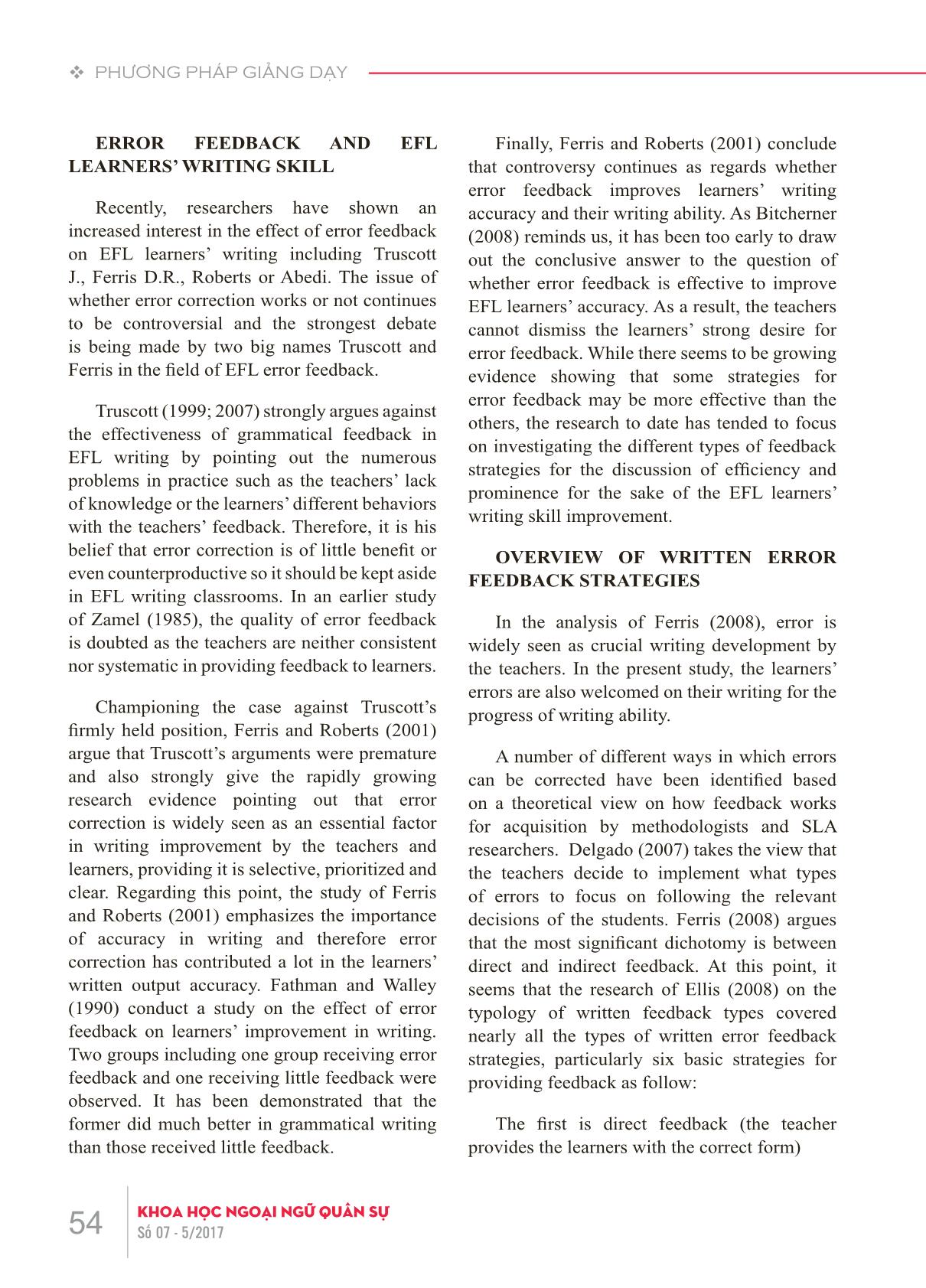
Trang 2

Trang 3
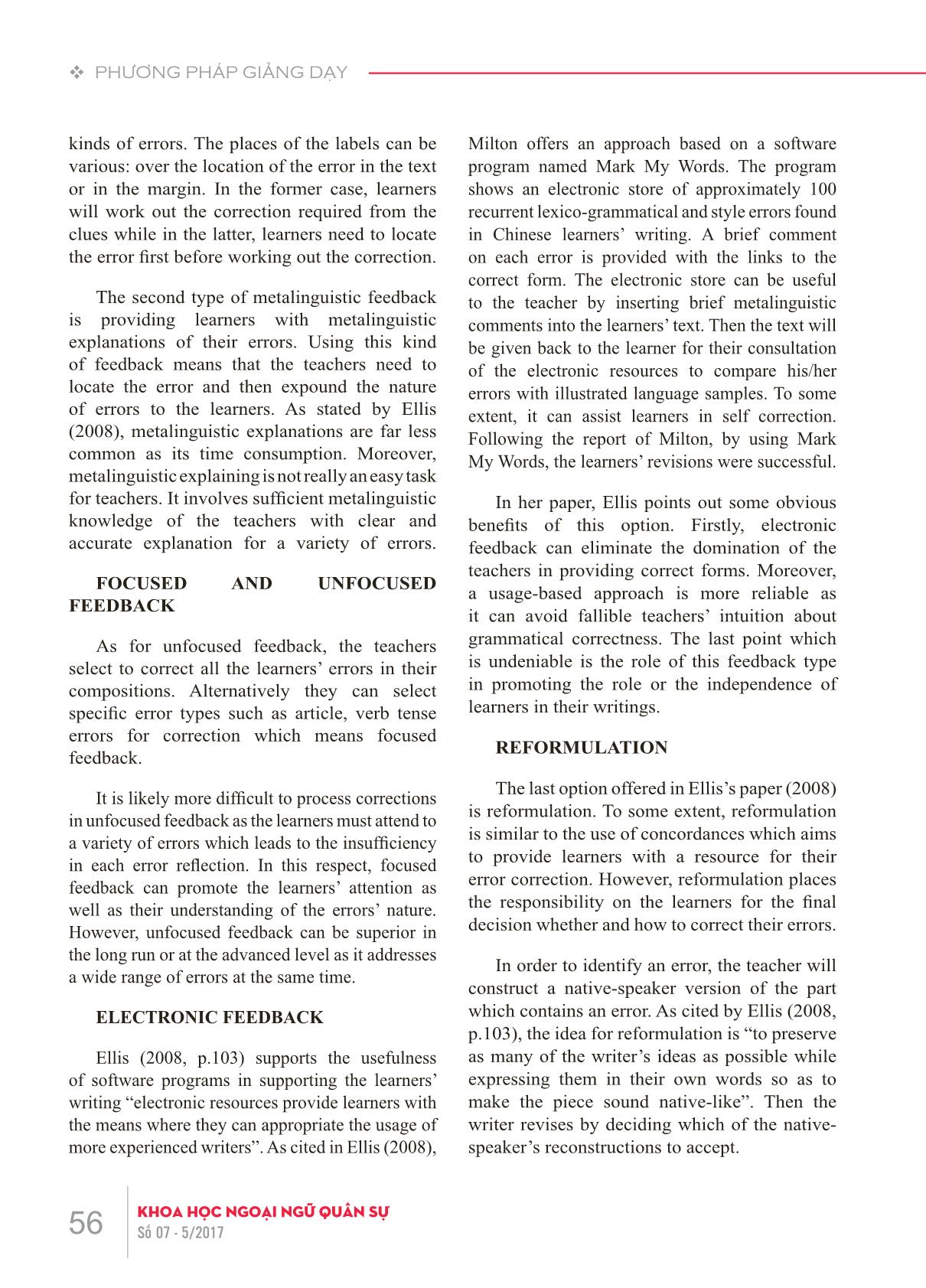
Trang 4
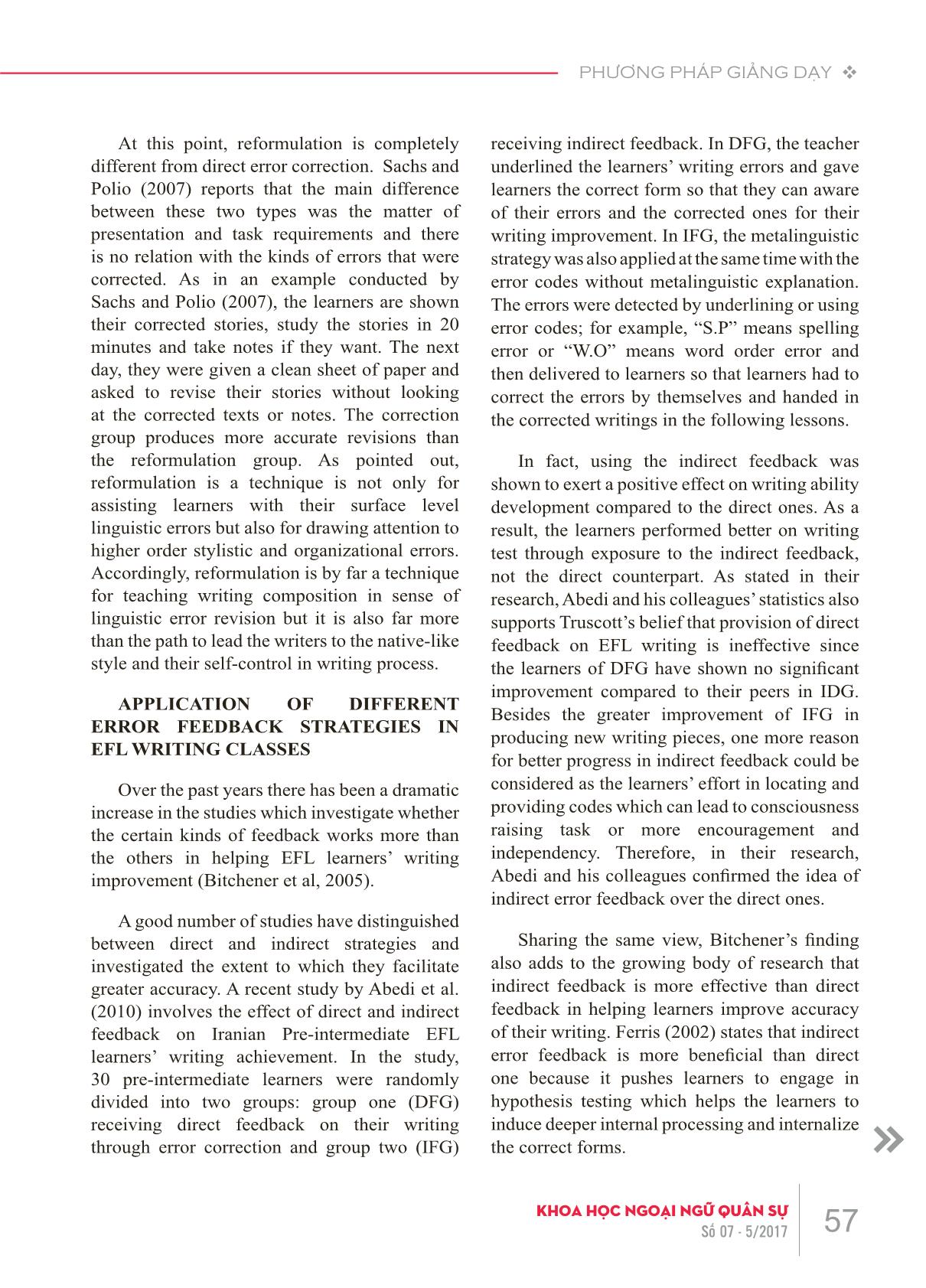
Trang 5
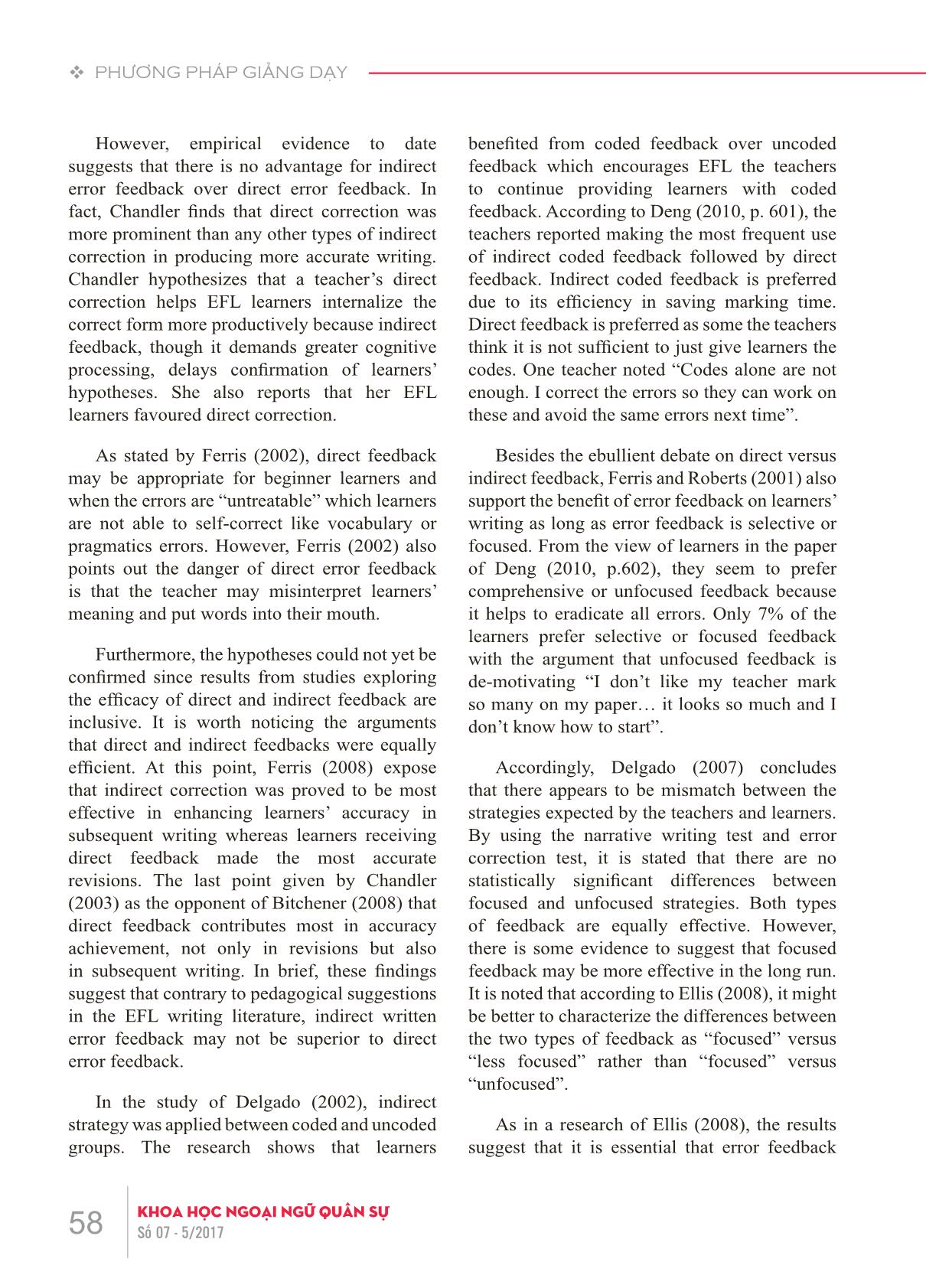
Trang 6
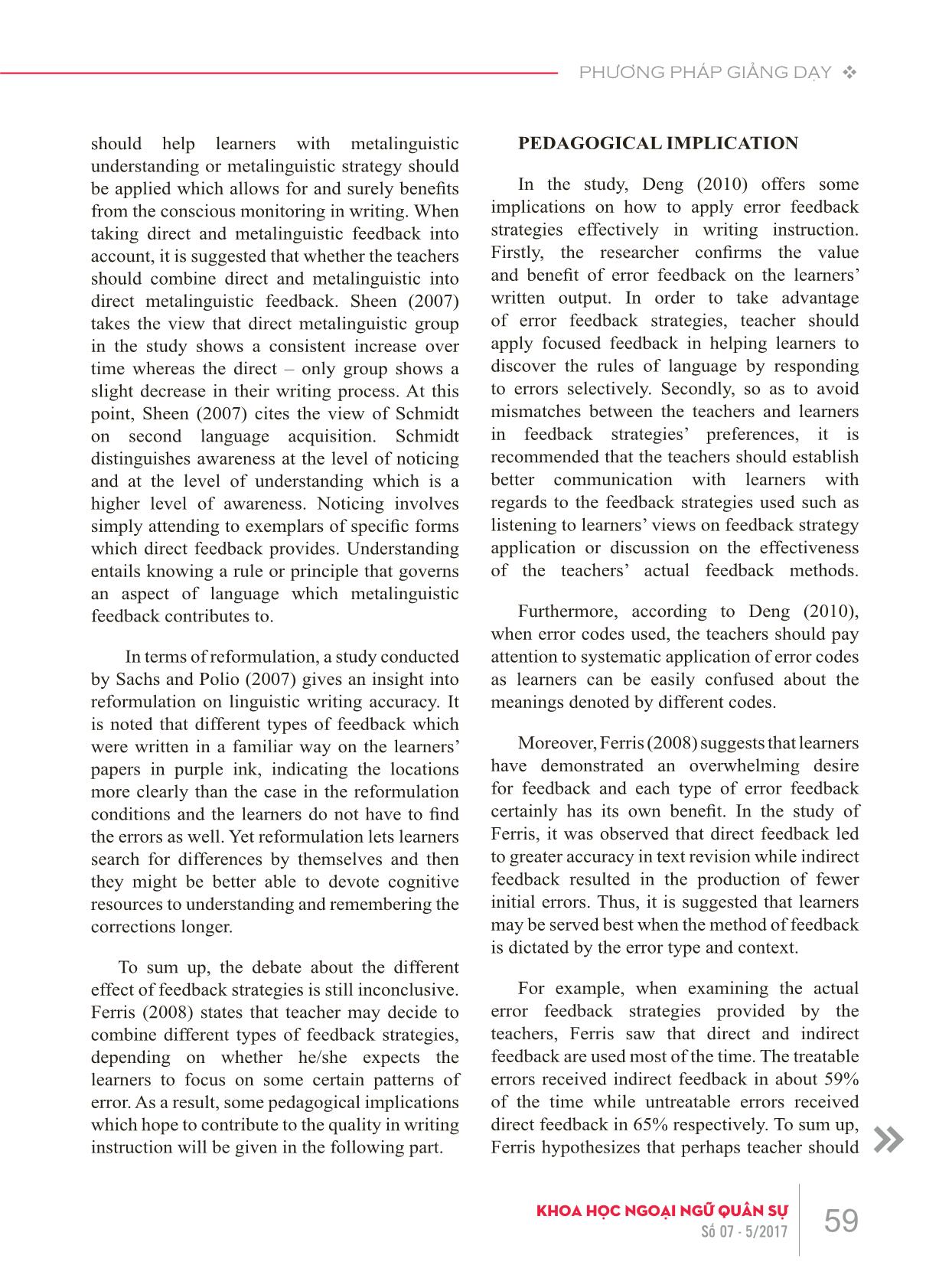
Trang 7
Tóm tắt nội dung tài liệu: Chiến lược chữa lỗi bài viết trong giảng dạy kỹ năng viết cho người học ngoại ngữ
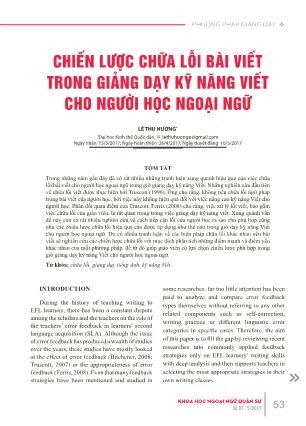
53KHOA HỌC NGOẠI NGỮ QUÂN SỰSố 07 - 5/2017 PHƯƠNG PHÁP GIẢNG DẠY v INTRODUCTION During the history of teaching writing to EFL learners, there has been a constant dispute among the scholars and the teachers on the role of the teachers’ error feedback in learners’ second language acquisition (SLA). Although the issue of error feedback has produced a wealth of studies over the years, these studies have mostly looked at the effect of error feedback (Bitchener, 2008; Truscott, 2007) or the appropriateness of error feedback (Ferris, 2008). Even that many feedback strategies have been mentioned and studied in LÊ THU HƯƠNG* *Đại học Kinh thế Quốc dân, ✉ lethuhuongp@gmail.com Ngày nhận: 13/3/2017; Ngày hoàn thiện: 26/4/2017; Ngày duyệt đăng: 10/5/2017 CHIẾN LƯỢC CHỮA LỖI BÀI VIẾT TRONG GIẢNG DẠY KỸ NĂNG VIẾT CHO NGƯỜI HỌC NGOẠI NGỮ TÓM TẮT Trong những năm gần đây đã có rất nhiều những tranh luận xung quanh hiệu quả của việc chữa lỗi bài viết cho người học ngoại ngữ trong giờ giảng dạy kỹ năng Viết. Những nghiên cứu đầu tiên về chữa lỗi viết được thực hiện bởi Truscott (1996). Ông cho rằng, không nên chữa lỗi ngữ pháp trong bài viết của người học, bởi việc này không hiệu quả đối với việc nâng cao kỹ năng Viết cho người học. Phản đối quan điểm của Truscott, Ferris (2008) cho rằng, việc xử lý lỗi viết, bao gồm việc chữa lỗi của giáo viên, là rất quan trọng trong việc giảng dạy kỹ năng viết. Xung quanh vấn đề này còn có rất nhiều nghiên cứu về cách tiếp cận lỗi của người học ra sao cho phù hợp cũng như các chiến lược chữa lỗi hiệu quả cần được áp dụng như thế nào trong giờ dạy kỹ năng Viết cho người học ngoại ngữ. Do có nhiều tranh luận về các biện pháp chữa lỗi khác nhau nên bài viết sẽ nghiên cứu các chiến lược chữa lỗi với mục đích phân tích những điểm mạnh và điểm yếu khác nhau của mỗi phương pháp, để từ đó giúp giáo viên có lựa chọn chiến lược phù hợp trong giờ giảng dạy kỹ năng Viết cho người học ngoại ngữ. Từ khóa: chữa lỗi, giảng dạy tiếng Anh, kỹ năng Viết. some researches, far too little attention has been paid to analyze and compare error feedback types themselves without referring to any other related components such as self-correction, writing practice or different linguistic error categories in specific cases. Therefore, the aim of this paper is to fill the gap by reviewing recent researches into commonly applied feedback strategies only on EFL learners’ writing skills with deep analysis and then supports teachers in selecting the most appropriate strategies in their own writing classes. 54 KHOA HỌC NGOẠI NGỮ QUÂN SỰSố 07 - 5/2017 v PHƯƠNG PHÁP GIẢNG DẠY ERROR FEEDBACK AND EFL LEARNERS’ WRITING SKILL Recently, researchers have shown an increased interest in the effect of error feedback on EFL learners’ writing including Truscott J., Ferris D.R., Roberts or Abedi. The issue of whether error correction works or not continues to be controversial and the strongest debate is being made by two big names Truscott and Ferris in the field of EFL error feedback. Truscott (1999; 2007) strongly argues against the effectiveness of grammatical feedback in EFL writing by pointing out the numerous problems in practice such as the teachers’ lack of knowledge or the learners’ different behaviors with the teachers’ feedback. Therefore, it is his belief that error correction is of little benefit or even counterproductive so it should be kept aside in EFL writing classrooms. In an earlier study of Zamel (1985), the quality of error feedback is doubted as the teachers are neither consistent nor systematic in providing feedback to learners. Championing the case against Truscott’s firmly held position, Ferris and Roberts (2001) argue that Truscott’s arguments were premature and also strongly give the rapidly growing research evidence pointing out that error correction is widely seen as an essential factor in writing improvement by the teachers and learners, providing it is selective, prioritized and clear. Regarding this point, the study of Ferris and Roberts (2001) emphasizes the importance of accuracy in writing and therefore error correction has contributed a lot in the learners’ written output accuracy. Fathman and Walley (1990) conduct a study on the effect of error feedback on learners’ improvement in writing. Two groups including one group receiving error feedback and one receiving little feedback were observed. It has been demonstrated that the former did much better in grammatical writing than those received little feedback. Finally, Ferris and Roberts (2001) conclude that controversy continues as regards whether error feedback improves learners’ writing accuracy and their writing ability. As Bitcherner (2008) reminds us, it has been too early to draw out the conclusive answer to the question of whether error feedback is effective to improve EFL learners’ accuracy. As a result, the teachers cannot dismiss the learners’ strong desire for error feedback. While there seems to be growing evidence showing that some strategies for error feedback may be more effective than the others, the research to date has tended to focus on investigating the different types of feedback strategies for the discussion of efficiency and prominence for the sake of the EFL learners’ writing skill improvement. OVERVIEW OF WRITTEN ERROR FEEDBACK STRATEGIES In the analysis of Ferris (2008), error is widely seen as crucial writing development by the teachers. In the present study, the learners’ errors are also welcomed on their writing for the progress of writing ability. A number of different ways in which errors can be corrected have been identified based on a theoretical view on how feedback works for acquisition by methodologists and SLA researchers. Delgado (2007) takes the view that the teachers decide ... the text will be given back to the learner for their consultation of the electronic resources to compare his/her errors with illustrated language samples. To some extent, it can assist learners in self correction. Following the report of Milton, by using Mark My Words, the learners’ revisions were successful. In her paper, Ellis points out some obvious benefits of this option. Firstly, electronic feedback can eliminate the domination of the teachers in providing correct forms. Moreover, a usage-based approach is more reliable as it can avoid fallible teachers’ intuition about grammatical correctness. The last point which is undeniable is the role of this feedback type in promoting the role or the independence of learners in their writings. REFORMULATION The last option offered in Ellis’s paper (2008) is reformulation. To some extent, reformulation is similar to the use of concordances which aims to provide learners with a resource for their error correction. However, reformulation places the responsibility on the learners for the final decision whether and how to correct their errors. In order to identify an error, the teacher will construct a native-speaker version of the part which contains an error. As cited by Ellis (2008, p.103), the idea for reformulation is “to preserve as many of the writer’s ideas as possible while expressing them in their own words so as to make the piece sound native-like”. Then the writer revises by deciding which of the native- speaker’s reconstructions to accept. 57KHOA HỌC NGOẠI NGỮ QUÂN SỰSố 07 - 5/2017 PHƯƠNG PHÁP GIẢNG DẠY v At this point, reformulation is completely different from direct error correction. Sachs and Polio (2007) reports that the main difference between these two types was the matter of presentation and task requirements and there is no relation with the kinds of errors that were corrected. As in an example conducted by Sachs and Polio (2007), the learners are shown their corrected stories, study the stories in 20 minutes and take notes if they want. The next day, they were given a clean sheet of paper and asked to revise their stories without looking at the corrected texts or notes. The correction group produces more accurate revisions than the reformulation group. As pointed out, reformulation is a technique is not only for assisting learners with their surface level linguistic errors but also for drawing attention to higher order stylistic and organizational errors. Accordingly, reformulation is by far a technique for teaching writing composition in sense of linguistic error revision but it is also far more than the path to lead the writers to the native-like style and their self-control in writing process. APPLICATION OF DIFFERENT ERROR FEEDBACK STRATEGIES IN EFL WRITING CLASSES Over the past years there has been a dramatic increase in the studies which investigate whether the certain kinds of feedback works more than the others in helping EFL learners’ writing improvement (Bitchener et al, 2005). A good number of studies have distinguished between direct and indirect strategies and investigated the extent to which they facilitate greater accuracy. A recent study by Abedi et al. (2010) involves the effect of direct and indirect feedback on Iranian Pre-intermediate EFL learners’ writing achievement. In the study, 30 pre-intermediate learners were randomly divided into two groups: group one (DFG) receiving direct feedback on their writing through error correction and group two (IFG) receiving indirect feedback. In DFG, the teacher underlined the learners’ writing errors and gave learners the correct form so that they can aware of their errors and the corrected ones for their writing improvement. In IFG, the metalinguistic strategy was also applied at the same time with the error codes without metalinguistic explanation. The errors were detected by underlining or using error codes; for example, “S.P” means spelling error or “W.O” means word order error and then delivered to learners so that learners had to correct the errors by themselves and handed in the corrected writings in the following lessons. In fact, using the indirect feedback was shown to exert a positive effect on writing ability development compared to the direct ones. As a result, the learners performed better on writing test through exposure to the indirect feedback, not the direct counterpart. As stated in their research, Abedi and his colleagues’ statistics also supports Truscott’s belief that provision of direct feedback on EFL writing is ineffective since the learners of DFG have shown no significant improvement compared to their peers in IDG. Besides the greater improvement of IFG in producing new writing pieces, one more reason for better progress in indirect feedback could be considered as the learners’ effort in locating and providing codes which can lead to consciousness raising task or more encouragement and independency. Therefore, in their research, Abedi and his colleagues confirmed the idea of indirect error feedback over the direct ones. Sharing the same view, Bitchener’s finding also adds to the growing body of research that indirect feedback is more effective than direct feedback in helping learners improve accuracy of their writing. Ferris (2002) states that indirect error feedback is more beneficial than direct one because it pushes learners to engage in hypothesis testing which helps the learners to induce deeper internal processing and internalize the correct forms. 58 KHOA HỌC NGOẠI NGỮ QUÂN SỰSố 07 - 5/2017 v PHƯƠNG PHÁP GIẢNG DẠY However, empirical evidence to date suggests that there is no advantage for indirect error feedback over direct error feedback. In fact, Chandler finds that direct correction was more prominent than any other types of indirect correction in producing more accurate writing. Chandler hypothesizes that a teacher’s direct correction helps EFL learners internalize the correct form more productively because indirect feedback, though it demands greater cognitive processing, delays confirmation of learners’ hypotheses. She also reports that her EFL learners favoured direct correction. As stated by Ferris (2002), direct feedback may be appropriate for beginner learners and when the errors are “untreatable” which learners are not able to self-correct like vocabulary or pragmatics errors. However, Ferris (2002) also points out the danger of direct error feedback is that the teacher may misinterpret learners’ meaning and put words into their mouth. Furthermore, the hypotheses could not yet be confirmed since results from studies exploring the efficacy of direct and indirect feedback are inclusive. It is worth noticing the arguments that direct and indirect feedbacks were equally efficient. At this point, Ferris (2008) expose that indirect correction was proved to be most effective in enhancing learners’ accuracy in subsequent writing whereas learners receiving direct feedback made the most accurate revisions. The last point given by Chandler (2003) as the opponent of Bitchener (2008) that direct feedback contributes most in accuracy achievement, not only in revisions but also in subsequent writing. In brief, these findings suggest that contrary to pedagogical suggestions in the EFL writing literature, indirect written error feedback may not be superior to direct error feedback. In the study of Delgado (2002), indirect strategy was applied between coded and uncoded groups. The research shows that learners benefited from coded feedback over uncoded feedback which encourages EFL the teachers to continue providing learners with coded feedback. According to Deng (2010, p. 601), the teachers reported making the most frequent use of indirect coded feedback followed by direct feedback. Indirect coded feedback is preferred due to its efficiency in saving marking time. Direct feedback is preferred as some the teachers think it is not sufficient to just give learners the codes. One teacher noted “Codes alone are not enough. I correct the errors so they can work on these and avoid the same errors next time”. Besides the ebullient debate on direct versus indirect feedback, Ferris and Roberts (2001) also support the benefit of error feedback on learners’ writing as long as error feedback is selective or focused. From the view of learners in the paper of Deng (2010, p.602), they seem to prefer comprehensive or unfocused feedback because it helps to eradicate all errors. Only 7% of the learners prefer selective or focused feedback with the argument that unfocused feedback is de-motivating “I don’t like my teacher mark so many on my paper it looks so much and I don’t know how to start”. Accordingly, Delgado (2007) concludes that there appears to be mismatch between the strategies expected by the teachers and learners. By using the narrative writing test and error correction test, it is stated that there are no statistically significant differences between focused and unfocused strategies. Both types of feedback are equally effective. However, there is some evidence to suggest that focused feedback may be more effective in the long run. It is noted that according to Ellis (2008), it might be better to characterize the differences between the two types of feedback as “focused” versus “less focused” rather than “focused” versus “unfocused”. As in a research of Ellis (2008), the results suggest that it is essential that error feedback 59KHOA HỌC NGOẠI NGỮ QUÂN SỰSố 07 - 5/2017 PHƯƠNG PHÁP GIẢNG DẠY v should help learners with metalinguistic understanding or metalinguistic strategy should be applied which allows for and surely benefits from the conscious monitoring in writing. When taking direct and metalinguistic feedback into account, it is suggested that whether the teachers should combine direct and metalinguistic into direct metalinguistic feedback. Sheen (2007) takes the view that direct metalinguistic group in the study shows a consistent increase over time whereas the direct – only group shows a slight decrease in their writing process. At this point, Sheen (2007) cites the view of Schmidt on second language acquisition. Schmidt distinguishes awareness at the level of noticing and at the level of understanding which is a higher level of awareness. Noticing involves simply attending to exemplars of specific forms which direct feedback provides. Understanding entails knowing a rule or principle that governs an aspect of language which metalinguistic feedback contributes to. In terms of reformulation, a study conducted by Sachs and Polio (2007) gives an insight into reformulation on linguistic writing accuracy. It is noted that different types of feedback which were written in a familiar way on the learners’ papers in purple ink, indicating the locations more clearly than the case in the reformulation conditions and the learners do not have to find the errors as well. Yet reformulation lets learners search for differences by themselves and then they might be better able to devote cognitive resources to understanding and remembering the corrections longer. To sum up, the debate about the different effect of feedback strategies is still inconclusive. Ferris (2008) states that teacher may decide to combine different types of feedback strategies, depending on whether he/she expects the learners to focus on some certain patterns of error. As a result, some pedagogical implications which hope to contribute to the quality in writing instruction will be given in the following part. PEDAGOGICAL IMPLICATION In the study, Deng (2010) offers some implications on how to apply error feedback strategies effectively in writing instruction. Firstly, the researcher confirms the value and benefit of error feedback on the learners’ written output. In order to take advantage of error feedback strategies, teacher should apply focused feedback in helping learners to discover the rules of language by responding to errors selectively. Secondly, so as to avoid mismatches between the teachers and learners in feedback strategies’ preferences, it is recommended that the teachers should establish better communication with learners with regards to the feedback strategies used such as listening to learners’ views on feedback strategy application or discussion on the effectiveness of the teachers’ actual feedback methods. Furthermore, according to Deng (2010), when error codes used, the teachers should pay attention to systematic application of error codes as learners can be easily confused about the meanings denoted by different codes. Moreover, Ferris (2008) suggests that learners have demonstrated an overwhelming desire for feedback and each type of error feedback certainly has its own benefit. In the study of Ferris, it was observed that direct feedback led to greater accuracy in text revision while indirect feedback resulted in the production of fewer initial errors. Thus, it is suggested that learners may be served best when the method of feedback is dictated by the error type and context. For example, when examining the actual error feedback strategies provided by the teachers, Ferris saw that direct and indirect feedback are used most of the time. The treatable errors received indirect feedback in about 59% of the time while untreatable errors received direct feedback in 65% respectively. To sum up, Ferris hypothesizes that perhaps teacher should
File đính kèm:
 chien_luoc_chua_loi_bai_viet_trong_giang_day_ky_nang_viet_ch.pdf
chien_luoc_chua_loi_bai_viet_trong_giang_day_ky_nang_viet_ch.pdf

